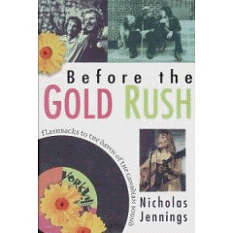| |
Nicholas Jennings

Before the Gold Rush
Viking - 1997
Michael Panontin
|
The major pop-rock scenes of the 1960s, Haight-Ashbury, Sunset Strip and Greenwich Village in the US and Liverpool and Carnaby Street across the pond, have all been done to death, both in print and on those 'History of Rock and Roll' programs that trot out the same tired, old icons of rock: the Doors, the Velvets, Pink Floyd and the Grateful Dead. It's the lesser-known scenes that are far more fascinating, like Detroit/Ann Arbor, Texas' International Artists roster and, here in Before the Gold Rush, Toronto's Yorkville and Yonge Street strip.
The pioneering Village Voice rock critic Richard Goldstein once visited the burgeoning Yorkville scene back in 1967 and with the sort of contempt that New Yorkers seem to possess in unlimited quantities, dismissed it as "a hippie Disneyland" and "premeditated like a carnival". He also wrote that "unlike Haight-Ashbury or the East Village, Yorkville is a high-rent district, filled with quaint cottages and high-rise formica [and] even the air is remarkably reekless for a hippie neighbourhood".
Ouch!
Toronto-based Nicholas Jennings, on the other hand, revels in the lore of the underrated Yorkville with the sort of perception and aplomb that only an insider can bring. His Before the Gold Rush chronicles the scene from its early days as a folkie haven to the more hard-rocking blues and psychedelia of its later years. The former saw the likes of Ian and Sylvia, Gordon Lightfoot and Joni Mitchell trolling the myriad bars and coffee houses, while the latter featured groups like the pre-Steppenwolf Sparrow and the Mynah Birds, a budding supergroup containing Neil Young and Bruce Palmer, pre-Buffalo Springfield, and fronted by a young Buffalo transplant, Ricky Matthews, a.k.a. Rick James.
Though the book ostensibly covers the entire nation's scene - indeed, its subtitle reads 'Flashback to the Dawn of the Canadian Sound' - from the Guess Who out in Winnipeg to Leonard Cohen in Montreal, its scope is decidedly and unapologetically Torontocentric. And this is hardly a bad thing since it provides Jennings with a focus, allowing him to plumb the depths of Yorkville for nugget after nugget of invaluable facts, stories and pictures.
The book is a veritable font of trivia for collectors and nostalgia buffs. For instance, there is a photo of Buffy Sainte-Marie at the Toronto Love-In at Queen's Park, May 22, 1967 with a young, square-headed Clayton Ruby (Canada's preeminent human rights lawyer) in the front row. An angelic Joni Mitchell graces the cover of Hoot magazine (Sept. 1966 - 40 cents!). Newspaper clippings from the L.A. Free Press ask, "Are Paupers Destined to Surpass Beatles?", surely one of the least prescient observations in the annals of rock journalism. And we learn that a rookie journalist named Stan Fischler (the soon-to-be revered hockey scribe) was sent to New York to cover a Sparrow gig at the venerable psych club Arthur.
And on and on the book goes. There are plenty of photos of rare singles and picture sleeves to appease collectors (though regrettably no discographies), a cool map highlighting the nearly 50 bars and clubs dotting the central core of Toronto and even a list of the author's top 25 Canadian songs from 1961-1971 that includes '1-2-5' by the Haunted, the Mandala's 'Opportunity', the anti-Vietnam 'Brain Washed' by a young David Clayton-Thomas and the Ugly Ducklings' 'Gaslight'.
From the sexual (Ronnie Hawkins had a water bed to entertain groupies in his third-floor office above the Le Coq d'Or) to the sinister (cultural icon June Callwood recalls how local bikers the Vagabonds, initially a colourful addition to the scene, eventually became involved in gang rapes, or 'pulling train' as it was known back then, and the trafficking of speed and heroin) to the downright goofy (Toronto Maple Leafs goalie Johnny Bower singing 'Honky the Christmas Goose' on Capitol in 1965!), the anecdotes and trivia are seemingly boundless.
All of which goes to prove that, at least for smug New York journalists, it's hard to keep your nose to the (under)ground when it's stuck so high in the air.
|
Nicholas Jennings
|
Suggestions

Brian Kendall
Our Hearts Went Boom (The Beatles Invasion of Canada)
Viking

Polaris!
Polaris!
Iglu
|








